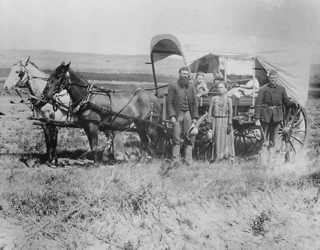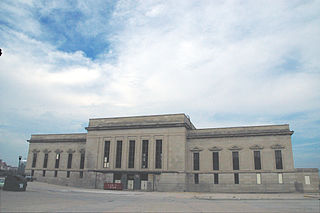Related Research Articles

America's first transcontinental railroad was a 1,911-mile (3,075 km) continuous railroad line constructed between 1863 and 1869 that connected the existing eastern U.S. rail network at Council Bluffs, Iowa, with the Pacific coast at the Oakland Long Wharf on San Francisco Bay. The rail line was built by three private companies over public lands provided by extensive US land grants. Building was financed by both state and US government subsidy bonds as well as by company-issued mortgage bonds. The Western Pacific Railroad Company built 132 miles (212 km) of track from the road's western terminus at Alameda/Oakland to Sacramento, California. The Central Pacific Railroad Company of California (CPRR) constructed 690 miles (1,110 km) east from Sacramento to Promontory Summit, Utah Territory. The Union Pacific Railroad (UPRR) built 1,085 miles (1,746 km) from the road's eastern terminus at the Missouri River settlements of Council Bluffs and Omaha, Nebraska, westward to Promontory Summit.

Columbus is a city in and the county seat of Platte County, in the state of Nebraska in the Midwestern United States. The population was 24,028 at the 2020 census, making it the 10th largest city in Nebraska.

The Union Pacific Railroad is a Class I freight-hauling railroad that operates 8,300 locomotives over 32,200 miles (51,800 km) routes in 23 U.S. states west of Chicago and New Orleans. Union Pacific is the second largest railroad in the United States after BNSF, with which it shares a duopoly on transcontinental freight rail lines in the Western, Midwestern and West South Central United States.

George Francis Train was an American entrepreneur who organized the clipper ship line that sailed around Cape Horn to San Francisco; he also organized the Union Pacific Railroad and the Credit Mobilier in the United States in 1864 to construct the eastern portion of the Transcontinental Railroad, and a horse tramway company in England while there during the American Civil War.

The Crédit Mobilier scandal was a two-part fraud conducted from 1864 to 1867 by the Union Pacific Railroad and the Crédit Mobilier of America construction company in the building of the eastern portion of the first transcontinental railroad. The story was broken by The New York Sun during the 1872 campaign of Ulysses S. Grant.
The Kansas Pacific Railway (KP) was a historic railroad company that operated in the western United States in the late 19th century. It was a federally chartered railroad, backed with government land grants. At a time when the first transcontinental railroad was being constructed by the Central Pacific and the Union Pacific, it tried and failed to join the transcontinental ranks. It was originally the "Union Pacific, Eastern Division", although it was completely independent. The Pennsylvania Railroad, working with Missouri financiers, designed it as a feeder line to the transcontinental system. The owners lobbied heavily in Washington for money to build a railroad from Kansas City to Colorado, and then to California. It failed to get funding to go west of Colorado. It operated many of the first long-distance lines in the state of Kansas in the 1870s, extending the national railway network westward across that state and into Colorado. Its main line furnished a principal transportation route that opened up settlement of the central Great Plains, and its link from Kansas City to Denver provided the last link in the coast-to-coast railway network in 1870. The railroad was consolidated with the Union Pacific in 1880, and its mainline continues to be an integral part of the Union Pacific network today.

Thomas Clark Durant was an American physician, businessman, and financier. He was vice-president of the Union Pacific Railroad (UP) in 1869 when it met with the Central Pacific railroad at Promontory Summit in Utah Territory. He created the financial structure that led to the Crédit Mobilier scandal. He was interested in hotels in the Adirondacks and once owned the yacht Idler.

The history of the U.S. state of Nebraska dates back to its formation as a territory by the Kansas–Nebraska Act, passed by the United States Congress on May 30, 1854. The Nebraska Territory was settled extensively under the Homestead Act of 1862 during the 1860s, and in 1867 was admitted to the Union as the 37th U.S. state. The Plains Indians are the descendants of a long line of succeeding cultures of indigenous peoples in Nebraska who occupied the area for thousands of years before European arrival and continue to do so today.

Transportation in Omaha, Nebraska, includes most major modes, such as pedestrian, bicycle, automobile, bus, train and airplane. While early transportation consisted of ferries, stagecoaches, steamboats, street railroads, and railroads, the city's transportation systems have evolved to include the Interstate Highway System, parklike boulevards and a variety of bicycle and pedestrian trails. The historic head of several important emigrant trails and the First transcontinental railroad, its center as a national transportation hub earned Omaha the nickname "Gate City of the West" as early as the 1860s.

Railroads in Omaha, Nebraska, have been integral to the growth and development of the city, the state of Nebraska, the Western United States and the entire United States. The convergence of many railroad forces upon the city was by happenstance and synergy, as none of the Omaha leaders had a comprehensive strategy for bringing railroads to the city.

Jesse Lowe was the first mayor of Omaha, Nebraska, serving for one year from March 5, 1857 to March 2, 1858. An important real estate agent in the early city, Lowe is credited with naming the city after the Omaha Tribe.

The Great Platte River Road was a major overland travel corridor approximately following the course of the Platte River in present-day Nebraska and Wyoming that was shared by several popular emigrant trails during the 19th century, including the Trapper's Trail, the Oregon Trail, the Mormon Trail, the California Trail, the Pony Express route, and the military road connecting Fort Leavenworth and Fort Laramie. The road, which extended nearly 370 miles (600 km) from the Second Fort Kearny to Fort Laramie, was utilized primarily from 1841 to 1866. In modern times it is often regarded as a sort of superhighway of its era, and has been referred to as "the grand corridor of America's westward expansion".
Train Town, today called the Credit Foncier Addition, was a suburb of Omaha, Nebraska owned by noted eccentric Union Pacific promoter George Francis Train's company called Credit Foncier of America. The area was 20 blocks by 20 blocks, which was approximately the size of Omaha at the time. It was located from Pierce Street southward to what is now the path of I-80, and from the Missouri River on the west to 20th Street.

George Pickering Bemis worked for nearly two decades as private secretary to his wealthy cousin, George Francis Train. He also acted as a real estate, loan and collection agent, and was later elected to one term as mayor of Omaha, Nebraska, USA.
The Irish in Omaha, Nebraska have constituted a major ethnic group throughout the history of the city, and continue to serve as important religious and political leaders. They compose a large percentage of the local population.

The Herndon House, later known as the International Hotel and then the Union Pacific Headquarters, was an early hotel located at Ninth and Farnam Streets in present-day Downtown Omaha, Nebraska. Built in 1858 by Omaha pioneer Dr. George L. Miller along with several associates, it was financed by the sale of city-donated land and a $16,000 loan. It was used as the headquarters building of the Union Pacific Railroad for more than 50 years; it was demolished in 1922.

The Overland Route was a train route operated jointly by the Union Pacific Railroad and the Central Pacific Railroad / Southern Pacific Railroad, between Council Bluffs, Iowa / Omaha, Nebraska, and the San Francisco Bay Area, over the grade of the first transcontinental railroad which had been opened on May 10, 1869. Passenger trains that operated over the line included the Overland Flyer, later renamed the Overland Limited, which also included a connection to Chicago. Although these passenger rail trains are no longer in operation, the Overland Route remains a common name for the line from Northern California to Chicago, now owned entirely by the Union Pacific. Although now primarily used for freight, a few portions still provide the route for the California Zephyr passenger train.
Enos Lowe was a pioneer doctor and businessman who was among the original founders of Omaha, Nebraska, and served as president of the Second Iowa Constitutional Convention.
The First Nebraska Territorial Legislature first met in Omaha, Nebraska, on January 15, 1855. The Council Bluffs and Nebraska Ferry Company provided the first meeting place, which was a building "constructed for public purposes". Standing out from the estimated twenty shacks in the young town, it was the first brick building in Omaha, which was founded the year before when the Nebraska Territory was created. Responsible for several important decisions that laid an important foundation for the future statehood for Nebraska, the Nebraska Territorial Legislature made controversial decisions and provided leadership for the territory.

The history of the Union Pacific Railroad stretches from 1862 to the present. For operations of the current railroad, see Union Pacific Railroad; for the holding company that owns the current railroad, see Union Pacific Corporation.
References
- 1 2 Reps, John W. (1992) [First published 1965]. The Making of Urban America. A History of City Planning in the United States. Princeton University Press. p. 402. ISBN 978-0691006185.
- ↑ Morton, A. (1966) The Great American Land Bubble: The Amazing Story of Land-grabbing. Johnson Reprint Corp. p 290.
- 1 2 Morton, J.S., et al. (1918) History of Nebraska. Western Publishing and Engraving Company. p 349.
- ↑ Quiett, G.C. (1939) They Built the West: An Epic of Rails and Cities. D. Appleton-Century Company, incorporated. p 157.
- 1 2 McCague, J. (1964) Moguls and Iron Men: The Story of the First Transcontinental Railroad. Harper and Row. p 135.
- ↑ Holland, P.G. (nd) "George Francis Train and the Woman Suffrage Movement, 1867-70". Archived 2008-07-06 at the Wayback Machine University of Iowa. Retrieved 4/10/08.
- ↑ Montgomery, D. (1961) Beyond Equality: Labor and the Radical Republicans, 1862-1872. University of Illinois Press. p 21.
- ↑ Larsen, Lawrence H.; Cottrell, Barbara J.; Dalstrom, Harl A.; Dalstrom, Kay Calamé (2007). Upstream Metropolis: An Urban Biography of Omaha and Council Bluffs. Lincoln, NE: University of Nebraska Press. p. 152. ISBN 978-0-8032-8002-1.
- ↑ Curry, M. (1950) The History of Platte County, Nebraska. Murray & Gee. p. 45.
- ↑ Train, G.F. (1902, 2007) My life in many states and in foreign. Kessinger Publishing, LLC.
- ↑ "Platte County," Andreas' history of Nebraska. Retrieved 4/10/08.
- ↑ Howard, R.W. (1962) The Great Iron Trail: The Story of the First Transcontinental Railroad. Putnam. p. 206.
- ↑ White, J.T. (1893) The National Cyclopaedia of American Biography. J. T. White company. p 557.
- ↑ Stanley, H.M. (1895) My Early Travels and Adventures in America and Asia. C. Scribner's Sons. p 193.